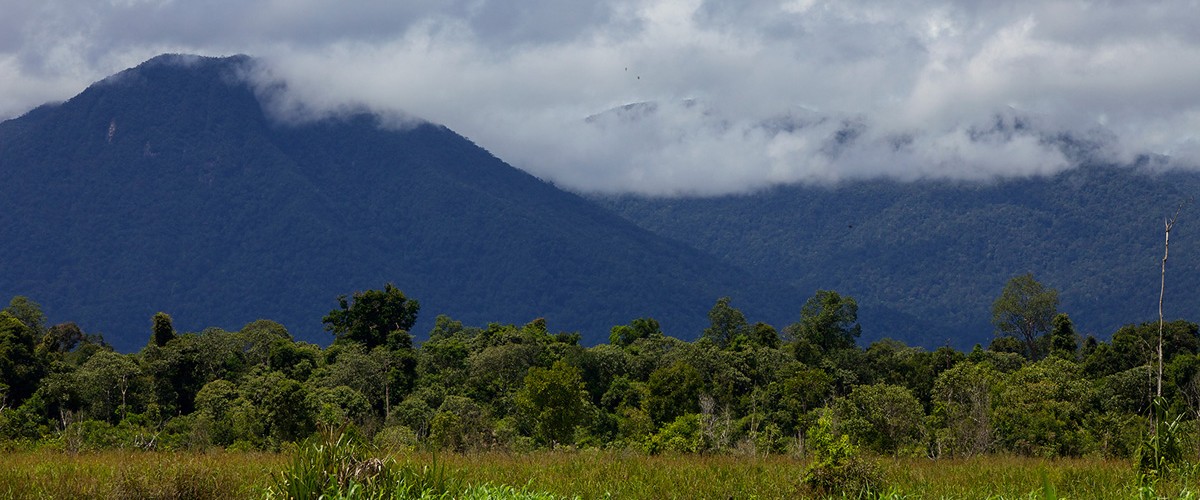By Brodie Philp, GPOCP Research Manager
With over 60 kilometers of trails surrounding Cabang Panti Research Station, the search for orangutans can range far and wide. Often, individual trees of a particular species are fruiting at the same time or fruiting may be concentrated in a particular habitat. So a lot of our energy can focus on one area if fruit is abundant there.
Getting to that spot can often be arduous. When following orangutans we need to arrive at the nest before they wake up. If the location is far from camp, this may mean leaving camp at 3:00 am to make it to the nest before the orangutans awake from their slumber. Closer locations mean a departure around4:15. A lot of this can also depend on the individual being followed. Some are early birds and are notorious among the field assistants for venturing out in the dark. Others like to sleep in and to take their time in the morning. Then there is the weather and terrain to consider. Heavy rainfalls can significantly slow you down when walking through the swamp. During a downpour everyone jumps, shuffles and manoeuvres their way through puddles or rivers, desperately trying to avoid water exceeding that critical point where it tips over the top of your boots. No one likes to spend a 14 hour day with wet feet if it can be avoided! The mountain terrain is drier and generally easier to navigate, however it can be quite steep. Arriving at the nest for a mountain follow normally brings relief as you can rest your burning calves, wipe the sweat from your face and stop regretting your early breakfast.
 |
|
Research assistants, Hassan (front) and Dong (back) collecting data and trying to keep their feet dry while following an orangutan. Photo by Brodie Philp.
|
Recently, though, we got to avoid these early morning treks to the orangutan nest, as we had orangutans nesting within 50 meters of camp! Walking around camp this month I was amused to see tagged feeding trees right above the assistants’ bedroom, the camp toilets or above the outside dining table. This time around a large fruiting Artocarpus was the major attraction bringing everyone so close to the research station.
One afternoon, while sitting in the lab upstairs, I saw movement in the trees. I rushed out the back with binoculars to find two orangutans, one of whom was munching on an Artocarpus fruit. These fruits are about the size of an orange and are in the same genus as the cultivated breadfruit and jackfruit. Little did we know just how much time we would be spending around that single tree. The original orangutan to discover it was an adolescent female named Berani. Although fully independent, Berani frequently spends time with her mother, Bibi, and infant brother, Bayas, as they occupy overlapping home ranges. It was not long before Bibi and Bayas joined Berani in this tree and the feasting began. Falling fruit crashing against leaves and thumping into the mud below became our daily forest soundtrack. Berani would spend several hours in this tree each day, whereas Bibi very rarely left. After completing our 5 days of following, we saw another three orangutans come and visit this one tree. One of them was Bosman, who I assumed was Berani at first. They look nothing alike, but Bibi was completely calm with him feeding next to her, which is unusual for Bibi. Bayas enjoyed the male company stretching out to try and grab ahold of this new companion. Bilbo and Walimah also made brief appearances towards the end of the tree’s fruiting cycle.
 |
|
Berani hanging out in the Artocarpus tree. Photo by Brodie Philp.
|
Overall, there was a very different feel about this follow period. Aside from the obvious extra sleep that comes from following so close to camp, there was the bonuses that bathroom breaks could happen in an actual bathroom and that coffee could be consumed with ease. There were even a few orders of mie goreng(fried noodles) delivered by the camp cook. The small string that we normally run from the nest to the nearest trail each night was briefly tied onto the ping pong table at the back of camp, more for novelty rather than practicality. However, all the extra antics associated with these follows, brings up a very important message – despite this rainforest being vast in both size and biodiversity, sometimes an orangutan will highly depend on a single tree. All trees are important, but large ones like these are critical for a fully functioning ecosystem. This one tree’s fruit crop managed to not only feed several orangutans for an entire week but also numerous macaques, as well as the Bearded Pigs that cleaned up the scraps below. Soon the vine that entangles its trunk will fruit with figs that will also welcome in numerous bird and squirrel species and its hollows will house occupants and new rainforest arrivals for generations to come.
 |
|
The resident Bornean Bearded Pig cleaning up fruit scraps from the Artocarpus tree. Photo by Brodie Philp.
|
For the time being, the Artocarpus has stopped fruiting and we are back to expanding our orangutan searches far and wide. From the perspective of the research team, each day we have people on the ground within the national park, searching for and following orangutans, helps deter poachers and loggers. Meanwhile our conservation and education teams work to educate nearby communities about the importance of conserving this habitat and how to seek alternative sources of income. This allows all trees and creatures, big and small, to keep existing exactly as they are, in their wild, natural state.






